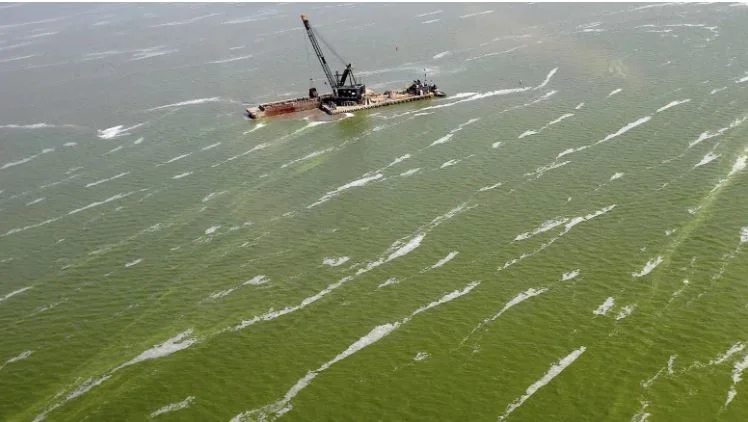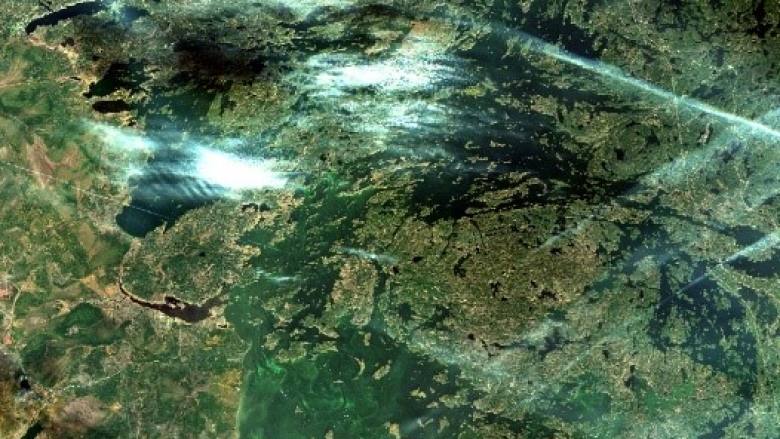Baljot Rai arrived carrying his project sign, covered with signatures of other students he met at the fair. Rai was selected as a finalist for the Canadian Stockholm Junior Water Prize for his work using zebra mussel shells to absorb phospherous in water. He and two other students from CWSF will submit reports on their projects, and the winner will compete for the Stockholm Junior Water Prize in Sweden in August 2023.
Forecast predicts 'moderate' sized algal bloom for western Lake Erie this summer
The National Oceanic and Atmospheric Administration (NOAA) is predicting a moderate bloom with a severity level of 2-6 on a scale of 1-10 for western Lake Erie this summer. The U.S. federal agency issued a bulletin last week after collecting data of phosphorus discharge into the Maumee River which dumps into the lake. "The range in forecasted severity reflects the uncertainty in forecasting precipitation for late June and July," the NOAA bulletin stated.
‘Now is the time to protect these wetlands’
Using high-resolution satellite images and computer modelling, researchers from the University of Waterloo have documented the importance small wetlands play in water purification and conservation. “What our work showed is that they are actually really important,” said Nandita Basu, a professor at the University of Waterloo and Canada Research Chair in Global Water Sustainability and Ecohydrology.
Reducing phosphorus runoff
Is it possible to reduce the amount of phosphorus being released from agricultural land and into waterways, such as Lake Winnipeg, during the spring melt? It’s a question UWinnipeg Professor Dr. Darshani Kumaragamage, Department of Environmental Studies and Sciences, and her research team are trying to answer. In most parts of the world, erosion, and rain-driven runoff are the major pathways by which phosphorus from agricultural fields enter waterbodies. However, in cold climates like the Canadian prairies, flooding-induced phosphorus loss during the snowmelt period is the dominant transport mechanism of phosphorus from agricultural lands to water bodies.
The International Red River Watershed Board to monitor key nutrients to help reduce the impact of harmful blooms in the Red River basin
To continue improving water quality in the Red River basin, including downstream in Lake Winnipeg, the governments of Canada and the United States approved four additional water quality objectives to be monitored by the International Red River Watershed Board (IRRWB) following a recommendation by the International Joint Commission (IJC). These additional, non-regulatory water quality objectives are for the key nutrients phosphorus and nitrogen.
Dead fish in San Francisco area blamed on toxic red tide
“We normally have algae blooms during the summertime. But what’s unusual about this one is how large it is and the fact that there are fish kills,” White said. Most algae blooms end after a week or so. But a triple-digit heat wave forecast for the holiday weekend may help the Bay Area's grow even more, White said. She said that reports of dead fish started coming in last week.
Wetland at Okanagan Falls sewer plant now fully up and running
The wetland project next to the Okanagan Falls wastewater treatment plant to polish treated effluent is now fully operational. The new wetland is operated by the Regional District of Okanagan-Similkameen and comprises 1.9 hectares of floodplain land adjacent to the Okanagan River. According to the RDOS, while wastewater treatment plant discharges clean effluent, during the summer months, the wetland allows for an additional one-third reduction of nitrogen and phosphorus loading to the Okanagan River.
Ducks Unlimited Canada delivers 106 habitat projects with support from the Natural Heritage Conservation Program
A report from one of the country’s largest and longest-standing conservation organizations shares the positive results it’s having on biodiversity and climate change thanks to support from Environment and Climate Change Canada’s Natural Heritage Conservation Program. During the past two years of the program, Ducks Unlimited Canada (DUC) has delivered 106 habitat projects in areas of the country with the greatest conservation need.
Halifax approves program to test for contaminants at 74 lakes
A new water quality monitoring program has been approved for the Halifax region that will see 74 lakes sampled beginning in spring 2022. The lakes will be tested for algae blooms and E. coli, as well as phosphorus, chlorophyll and chloride. According to the municipality's manager of environment, the lakes have been chosen based on scientific criteria. "It's based on our current understanding of their vulnerabilities," said Shannon Miedema. "We do have a thousand lakes within our municipal boundaries."
Government of Canada launches consultation process for new Canada Water Agency
“Through the Canada Water Agency, our government is looking to strengthen collaboration between the federal government, the provinces, territories, Indigenous peoples and other partners to find the best ways to safeguard our freshwater consultations are an important part of this process and I look forward to input from Canadians,” Terry Duguid said in a statement. Mr. Duguid is Parliamentary Secretary to Minister Wilkinson and has been key in the development process. The discussion paper, ‘Toward the Creation of a Canada Water Agency,’ presents key issues and provides an overview of the federal government’s existing activities to enhance freshwater management, and a virtual national freshwater policy forum is planned for January 27 and 28. A series of regional forums will be held in February that will provide additional opportunities to participate in consultations. The discussion paper and additional information can be found at placespeak.ca. Comments can be submitted until March 1.
A TALE OF THREE WATERSHEDS: WHAT WE KNOW — AND DON’T KNOW — ABOUT THE HEALTH OF CANADA’S FRESHWATER
Canada is famously home to 20 percent of the world’s freshwater — but how well are we stewarding this supply? WWF-Canada recently reassessed the health of our country’s 25 watersheds to better understand how they’re responding to threats from pollution, habitat loss and climate change. Our 2020 Watershed Reports found that 26 per cent of Canadas’s 167 sub-watersheds received a score of Good or Very Good, which is good or very good news! But what’s bad, or possibly very bad, is that nearly 60 per cent of these sub-watersheds received no score at all because they remain Data Deficient. In other words, we just don’t know. This lack of data is concerning as we need a complete picture to determine which areas need dedicated efforts to protect our freshwater ecosystems.
Young Innovators: New U of S app tracks causes of algae bloom
A new University of Saskatchewan smartphone app will help farmers and communities identify hotspots of nutrient contamination in freshwaters and possibly predict where algae blooms — slimy, plant-like green organisms that hinder water quality — are likely to grow. “Tracking how and where agricultural nutrients, which help crops grow, may be washed away with rainfalls and snowmelt is a major concern for both researchers and the public, and that’s where our app comes in,” said Environment and Climate Change Canada scientist Diogo Costa.
Winnipeg MP says federal government willing to help tackle Lake Winnipeg pollution
Help could be on the way to update the North End Sewage Treatment Plant and fight pollution in Lake Winnipeg. The Lake Winnipeg Foundation, an environmental non-governmental organization, said the city is the single largest contributor of phosphorus in the lake, at around five per cent. Winnipeg South MP Terry Duguid, parliamentary secretary to the minister of environment and climate change, told 680 CJOB the federal government is willing to do its part to tackle the problem, but the North End plant only serves as a starting point.
'A new normal': decreasing ice cover on the Great Lakes
The changes caused by declining ice cover on the Great Lakes are pretty bad, but it's not all doom and gloom. Ice cover on the Great Lakes has declined in the past 40 years with average ice coverage dropping up to 75 per cent, depending on the lake. "We rely a lot on the Great Lakes for shipping ... so an ice-free Great Lake is not a barrier to shipping. But beyond that there are a lot of negatives associated," said Mike McKay, the executive director for the Great Lakes Institute for Environmental Research (GLIER), based at the University of Windsor.
Stopping algae blooms may start on farmlands
A handful of Chatham farms might hold the answer to reducing toxic algae blooms in the Great Lakes. These farms are collecting and analyzing their agricultural runoff, in hope of reducing the amount of phosphorus entering the waterways. It's part of a project, started by two organizations in Spring 2016, which aims to come up with a strategy to deal with toxic algae blooms. Out of that idea for the project — between the Ontario Federation of Agriculture and the Great Lakes and St. Lawrence Cities Initiative — came the Thames River Phosphorus Reduction Collaborative.
'Hard on water:' Wildfire smoke can affect nearby water bodies for more than a decade, researchers say
Time to act on algae is now, says organization calling for Lake of the Woods phosphorus reduction
A watershed board focused on protecting Lake of the Woods is calling on Manitoba's provincial government to reduce the amount of phosphorus running into the basin. The organization wants the governments of Manitoba, Ontario and Canada to commit to an 18.4 per cent reduction in phosphorus loads to improve the health of the water body.


















